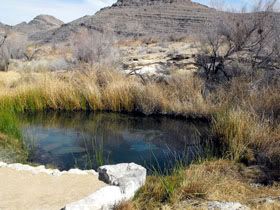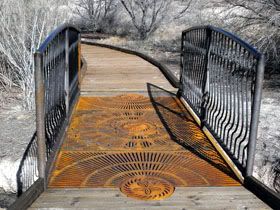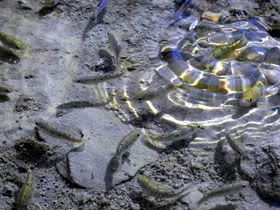Ash Meadows National Wildlife Refuge, Nevada

For a unique nature experience this year; travel to the unusual desert oasis in Nevada, Ash Meadows National Wildlife Refuge. Located an easy 90 mile drive northeast of Las Vegas, this 23,000 acre gem of clear springs harbors a surprising wealth of Southwestern bird life and endemic pupfish among the barren surroundings of alkaline desert.
We arrived one January day after driving about 20 miles to the visitor center off Highway 95 on easily-traversed gravel roads. The center was closed, but we picked up a brochure and enjoyed the Crystal Springs Interpretive Boardwalk Trail over the wetlands with bobcat tracks visible in the sand on either side, and Mesquite trees gracing the walk with shade. We were astonished to learn the refuge is both haven and habitat for 26 species of indigenous plant and animal life. This is the greatest concentration of any other local area in the United States, and the second greatest in all of North America!

The creative ironwork on the short bridges over the small streams are elegant and fitting with fish and wildlife themes. Along the way, we heard a bird call we could not identify until actually seeing its slim, dark shape and crested head- a male Phainopepla flitting among the treetops. This southwestern bird species is one of over 200 identified at the refuge. Bring your binoculars, especially during the spring and fall migrations, when species variety is at its peak.
 Lovely Crystal Springs awaited us at the end of the boardwalk. We relaxed on the benches, listening to the gurgling waters and observing the royal blue-colored male Amargosa Pupfish defend their territories chasing each other around in the 80 degree waters.Thirty seeps and springs and larger reservoirs dot the landscape, created from a vast underground fossil water system stretching 100 miles to the northeast and originating thousands of years ago.
Lovely Crystal Springs awaited us at the end of the boardwalk. We relaxed on the benches, listening to the gurgling waters and observing the royal blue-colored male Amargosa Pupfish defend their territories chasing each other around in the 80 degree waters.Thirty seeps and springs and larger reservoirs dot the landscape, created from a vast underground fossil water system stretching 100 miles to the northeast and originating thousands of years ago.
While eating a picnic lunch under the shelters provided; we reflected on the amazing story of these pupfish. All pupfish species are isolated in their springs or streams in the western deserts, relicts from a time thousands of years ago when the climate was far wetter. As the land dried out, the pupfish habitats became smaller and smaller, until today, most are endangered and threatened with extinction. The Amargosa pupfish is an exception; they are thriving in their protected habitat, eating algae, diatoms, and tiny invertebrates in the fossil waters.
 Three more pupfish species exist on the refuge. Warm Springs, Speckled Dace, and Devils Hole. Devils Hole pupfish are not faring so well. The pupfish is named for the 500ft deep, 92 degree water-filled cavern that is its only home. The cavern is now closed off to the public to protect the pupfish, whose population has dramatically declined over the past few years. You can still walk up to the edge and peer down into the waters, but a glimpse of the pupfish is illusive. They forage and spawn solely on a shallow rock shelf near the surface. Biologists are intensively studying this special habitat to try to reverse their population decline.
Three more pupfish species exist on the refuge. Warm Springs, Speckled Dace, and Devils Hole. Devils Hole pupfish are not faring so well. The pupfish is named for the 500ft deep, 92 degree water-filled cavern that is its only home. The cavern is now closed off to the public to protect the pupfish, whose population has dramatically declined over the past few years. You can still walk up to the edge and peer down into the waters, but a glimpse of the pupfish is illusive. They forage and spawn solely on a shallow rock shelf near the surface. Biologists are intensively studying this special habitat to try to reverse their population decline.
 Blooming endemic plants can be seen in the spring. Ash Meadows blazing star, Spring-loving centaury plant, and Ash Meadows sunray are a few of the protected species. Be sure to visit Point of Rocks and Crystal Reservoir for more birding opportunites and good informational displays.
Blooming endemic plants can be seen in the spring. Ash Meadows blazing star, Spring-loving centaury plant, and Ash Meadows sunray are a few of the protected species. Be sure to visit Point of Rocks and Crystal Reservoir for more birding opportunites and good informational displays.
As you travel through the refuge, a glimpse of a chuckwalla lizard tucked into a rock shelf might surprise you. Or you may be lucky enough to have a peach-colored coachwhip snake cross your path. A coyote hunts along a stream, and a roadrunner dodges through the grasses. Wildlife, birds, fish, an amazing oasis in the desert; visit Ash Meadows Wildlife Refuge and spend a day out of the ordinary.
Other information:
-All the roads in the refuge are gravel. Be sure to watch the weather; during and after rains, many of the roads are impassable. Bring sunscreen, hat, lunch, water and binoculars.
-The visitor center is open from 8am to 4pm Mon-Fri, but only when staff members are available.
-There are no fees and no facilities, other than restrooms and picnic shelters.
-The official website will assist in your planning:
https://www.fws.gov/desertcomplex/ashmeadov/

We arrived one January day after driving about 20 miles to the visitor center off Highway 95 on easily-traversed gravel roads. The center was closed, but we picked up a brochure and enjoyed the Crystal Springs Interpretive Boardwalk Trail over the wetlands with bobcat tracks visible in the sand on either side, and Mesquite trees gracing the walk with shade. We were astonished to learn the refuge is both haven and habitat for 26 species of indigenous plant and animal life. This is the greatest concentration of any other local area in the United States, and the second greatest in all of North America!

The creative ironwork on the short bridges over the small streams are elegant and fitting with fish and wildlife themes. Along the way, we heard a bird call we could not identify until actually seeing its slim, dark shape and crested head- a male Phainopepla flitting among the treetops. This southwestern bird species is one of over 200 identified at the refuge. Bring your binoculars, especially during the spring and fall migrations, when species variety is at its peak.
 Lovely Crystal Springs awaited us at the end of the boardwalk. We relaxed on the benches, listening to the gurgling waters and observing the royal blue-colored male Amargosa Pupfish defend their territories chasing each other around in the 80 degree waters.Thirty seeps and springs and larger reservoirs dot the landscape, created from a vast underground fossil water system stretching 100 miles to the northeast and originating thousands of years ago.
Lovely Crystal Springs awaited us at the end of the boardwalk. We relaxed on the benches, listening to the gurgling waters and observing the royal blue-colored male Amargosa Pupfish defend their territories chasing each other around in the 80 degree waters.Thirty seeps and springs and larger reservoirs dot the landscape, created from a vast underground fossil water system stretching 100 miles to the northeast and originating thousands of years ago.While eating a picnic lunch under the shelters provided; we reflected on the amazing story of these pupfish. All pupfish species are isolated in their springs or streams in the western deserts, relicts from a time thousands of years ago when the climate was far wetter. As the land dried out, the pupfish habitats became smaller and smaller, until today, most are endangered and threatened with extinction. The Amargosa pupfish is an exception; they are thriving in their protected habitat, eating algae, diatoms, and tiny invertebrates in the fossil waters.
 Three more pupfish species exist on the refuge. Warm Springs, Speckled Dace, and Devils Hole. Devils Hole pupfish are not faring so well. The pupfish is named for the 500ft deep, 92 degree water-filled cavern that is its only home. The cavern is now closed off to the public to protect the pupfish, whose population has dramatically declined over the past few years. You can still walk up to the edge and peer down into the waters, but a glimpse of the pupfish is illusive. They forage and spawn solely on a shallow rock shelf near the surface. Biologists are intensively studying this special habitat to try to reverse their population decline.
Three more pupfish species exist on the refuge. Warm Springs, Speckled Dace, and Devils Hole. Devils Hole pupfish are not faring so well. The pupfish is named for the 500ft deep, 92 degree water-filled cavern that is its only home. The cavern is now closed off to the public to protect the pupfish, whose population has dramatically declined over the past few years. You can still walk up to the edge and peer down into the waters, but a glimpse of the pupfish is illusive. They forage and spawn solely on a shallow rock shelf near the surface. Biologists are intensively studying this special habitat to try to reverse their population decline. Blooming endemic plants can be seen in the spring. Ash Meadows blazing star, Spring-loving centaury plant, and Ash Meadows sunray are a few of the protected species. Be sure to visit Point of Rocks and Crystal Reservoir for more birding opportunites and good informational displays.
Blooming endemic plants can be seen in the spring. Ash Meadows blazing star, Spring-loving centaury plant, and Ash Meadows sunray are a few of the protected species. Be sure to visit Point of Rocks and Crystal Reservoir for more birding opportunites and good informational displays.As you travel through the refuge, a glimpse of a chuckwalla lizard tucked into a rock shelf might surprise you. Or you may be lucky enough to have a peach-colored coachwhip snake cross your path. A coyote hunts along a stream, and a roadrunner dodges through the grasses. Wildlife, birds, fish, an amazing oasis in the desert; visit Ash Meadows Wildlife Refuge and spend a day out of the ordinary.
Other information:
-All the roads in the refuge are gravel. Be sure to watch the weather; during and after rains, many of the roads are impassable. Bring sunscreen, hat, lunch, water and binoculars.
-The visitor center is open from 8am to 4pm Mon-Fri, but only when staff members are available.
-There are no fees and no facilities, other than restrooms and picnic shelters.
-The official website will assist in your planning:
https://www.fws.gov/desertcomplex/ashmeadov/

Related Articles
Editor's Picks Articles
Top Ten Articles
Previous Features
Site Map
Content copyright © 2023 by Diane Pierce/Photos Roy Dailey. All rights reserved.
This content was written by Diane Pierce/Photos Roy Dailey. If you wish to use this content in any manner, you need written permission. Contact Hazel M. Freeman for details.



